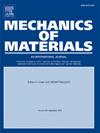基于速率相关黏结界面法和中尺度模型的混凝土动态断裂性能试验验证
IF 4.1
3区 材料科学
Q2 MATERIALS SCIENCE, MULTIDISCIPLINARY
引用次数: 0
摘要
本研究采用缺口半圆弯曲(NSCB)实验和速率相关内聚区模型(CZM)相结合的方法研究了混凝土在高加载速率下的动态断裂行为。实验装置采用分离式霍普金森压杆(SHPB)系统,结合高速数字图像相关(DIC)技术,实时捕捉裂纹扩展和变形。利用数字图像处理(DIP)和随机骨料生成技术建立了二维中尺度有限元模型,以复制混凝土的非均匀微观结构。在界面过渡区(ITZ)和聚集体-基体界面处集成具有速度依赖牵引-分离规律的内聚元素,模拟裂纹的萌生和扩展。结果表明,动态断裂韧性随加载速率线性增加,在120 MPa时的峰值比准静态断裂韧性高144%。缺口角度对混合模式断裂韧性影响显著,30°缺口角度下KIIC最大,为5.165。该研究表明,将速率效应和微观结构非均质性纳入内聚模型可提高预测精度,为设计受动荷载影响的混凝土结构提供重要见解。本文章由计算机程序翻译,如有差异,请以英文原文为准。
Experimental verification of dynamic fracture performance of concrete via rate-dependent cohesive interface approach and mesoscale model
This study investigates the dynamic fracture behavior of concrete under higher loading rate using a combination of notch semi-circular bending (NSCB) experiments and rate-dependent cohesive zone modelling (CZM). The experimental setup employed a split Hopkinson pressure bar (SHPB) system coupled with high-speed digital image correlation (DIC) to capture real-time crack propagation and deformation. A 2D mesoscale finite element model was developed using digital image processing (DIP) and random aggregate generation techniques to replicate the heterogeneous microstructure of concrete. Cohesive elements with velocity-dependent traction-separation laws were integrated at interfacial transition zones (ITZ) and aggregate-matrix interfaces to simulate crack initiation and growth. Results revealed that dynamic fracture toughness increased linearly with loading rates, with peak values up to 144 % higher than quasi-static counterparts at 120 MPa. Notch angle significantly influenced mixed-mode fracture toughness, with a maximum KIIC of 5.165 observed at a 30° notch angle. The study demonstrated that incorporating rate effects and microstructural heterogeneity into cohesive models improves predictive accuracy, offering critical insights for designing concrete structures subjected to dynamic loading.
求助全文
通过发布文献求助,成功后即可免费获取论文全文。
去求助
来源期刊

Mechanics of Materials
工程技术-材料科学:综合
CiteScore
7.60
自引率
5.10%
发文量
243
审稿时长
46 days
期刊介绍:
Mechanics of Materials is a forum for original scientific research on the flow, fracture, and general constitutive behavior of geophysical, geotechnical and technological materials, with balanced coverage of advanced technological and natural materials, with balanced coverage of theoretical, experimental, and field investigations. Of special concern are macroscopic predictions based on microscopic models, identification of microscopic structures from limited overall macroscopic data, experimental and field results that lead to fundamental understanding of the behavior of materials, and coordinated experimental and analytical investigations that culminate in theories with predictive quality.
 求助内容:
求助内容: 应助结果提醒方式:
应助结果提醒方式:


